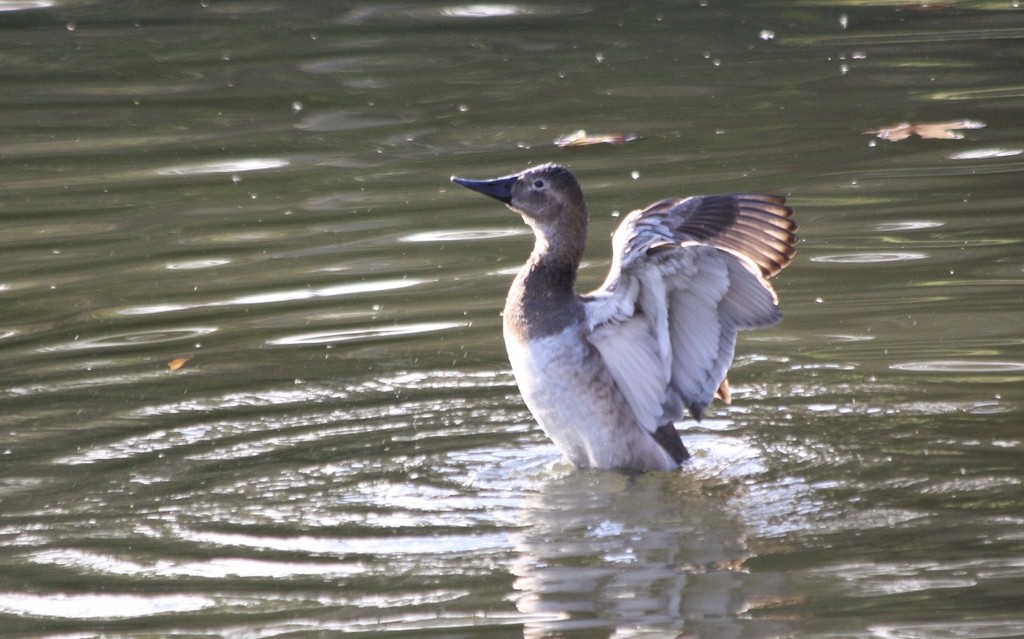Canvasback
A species of Diving ducks, Also known as King Of Ducks Scientific name : Aythya valisineria Genus : Diving ducks
Canvasback, A species of Diving ducks
Also known as:
King Of Ducks
Botanical name: Aythya valisineria
Genus: Diving ducks
 Photo By silversea_starsong , used under CC-BY-NC-4.0 /Cropped and compressed from original
Photo By silversea_starsong , used under CC-BY-NC-4.0 /Cropped and compressed from original Description
It ranges from 48–56 cm (19–22 in) in length and weighs 862–1,600 g (1.900–3.527 lb), with a wingspan of 79–89 cm (31–35 in). It is the largest species in the genus Aythya, being similar in size to a mallard but with a heavier and more compact build than it. 191 males wintering in western New York averaged 1,252 g (2.760 lb) and 54 females there averaged 1,154 g (2.544 lb). The canvasback has a distinctive wedge-shaped head and long graceful neck. The adult male (drake) has a black bill, a chestnut red head and neck, a black breast, a grayish back, black rump, and a blackish brown tail. The drake's sides, back, and belly are white with fine vermiculation resembling the weave of a canvas, which gave rise to the bird's common name. The bill is blackish and the legs and feet are bluish-gray. The iris is bright red in the spring, but duller in the winter. The adult female (hen) also has a black bill, a light brown head and neck, grading into a darker brown chest and foreback. The sides, flanks, and back are grayish brown. The bill is blackish and the legs and feet are bluish-gray. Its sloping profile distinguishes it from other ducks. 
Size
48-61 cm (19-24 in)
Life Expectancy
22 years
Nest Placement
Floating
Clutch Size
5 - 11 eggs
Incubation Period
1 brood
Number of Broods
24 - 29 days
Feeding Habits
Canvasback are omnivorous divers favoring aquatic plants' tubers, especially wild celery and sago pondweed. They also consume seeds, buds, leaves, roots, snails, and insect larvae. Canvasback dive to about 7 feet depth or dabble near the surface to forage. Diet adapts seasonally and with SAV availability, switching to Baltic Clams when necessary.
Habitat
Canvasback primarily inhabit wetlands, including lakes, salt bays, and estuaries; in summer, they favor fresh marshes. They nest in regions with deep water close to dense vegetation like cattails, rushes, and reed grass. During migration and winter, canvasback prefer marine and freshwater environments such as lagoons, rivers, ponds, and lakes, with occasional forays into flooded agricultural fields.
Nest Behavior
Canvasback's nesting period starts with females selecting a spot and constructing the nest; they incubate eggs for about 10 days, during which nest materials and down are added. Both parents partake in caring for the young.
Nest Characteristics
Canvasback's nest is a large, bulky platform located in shallow wetlands, often over water amongst cattails, rushes, sedges, and reeds. It is loosely woven from vegetation and sometimes features an emergent plant stalk canopy.
Dite type
Herbivorous
Migration Overview
The canvasback migrates through the Mississippi Flyway to wintering grounds in the mid-Atlantic United States and the Lower Mississippi Alluvial Valley (LMAV), or the Pacific Flyway to wintering grounds along the coast of California. Historically, the Chesapeake Bay wintered the majority of canvasbacks, but with the recent loss of submerged aquatic vegetation (SAV) in the bay, their range has shifted south towards the LMAV. Brackish estuarine bays and marshes with abundant submergent vegetation and invertebrates are ideal wintering habitat for canvasbacks. A small number of birds are also known to have crossed the Atlantic, with several sightings being recorded in the United Kingdom. In December 1996, a canvasback was observed in a quarry in Kent, which was followed by an additional sighting in Norfolk in January 1997. At least five more sightings have since been confirmed in England. 
General Info
Feeding Habits
Bird food type
Behavior
Canvasback are adept diving waterfowl, spending the majority of their time afloat, rarely venturing onto dry land. Daily, they rest on water, bills nestled cozily beneath wings. Launching into flight necessitates a sprint but once airborne, they exhibit potent, swift flight, capable of reaching speeds topping 56 mph. Outside breeding seasons, canvasback are gregarious, forming colossal, densely packed assemblies in the thousands. Resource scarcity in winter prompts territorial defense against conspecifics. Springtime and early breeding escalate their aggression, with display acts like bill dipping, jabbing, or even head pumping and pursuits. Mating rituals are elaborate; males showcase a repertoire of head movements and calls, culminating in pair formation. Post-mating, the males retire to molt in secluded, expansive wetlands, while females tirelessly incubate then tend to offspring, until migration beckons.
Species Status
Populations have fluctuated widely. Low levels in 1980s put the canvasback on lists of special concern, but numbers increased greatly in the 1990s. The canvasback is particularly vulnerable to drought and wetland drainage on the prairies of North America. Many species of ducks, including the canvasback, are highly migratory, but are effectively conserved by protecting the places where they nest, even though they may be hunted away from their breeding grounds. Protecting key feeding and breeding grounds is key for conserving many types of migratory birds. 